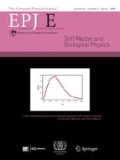Abstract
The evolution of an incompletely connected system of species with speciation and extinction is investigated in terms of random replicators. It is found that evolving random replicator systems with speciation do become large and complex, depending on speciation parameters. Antisymmetric interactions result in large systems, whereas systems with symmetric interactions remain small. A co-dominating feature is within-species interaction pressure: large within-species interaction increases species diversity. Average fitness evolves in all systems, however symmetry and connectivity evolve in small systems only. Newcomers get extinct almost immediately in symmetric systems. The distribution in species lifetimes is determined for antisymmetric systems. The replicator systems investigated do not show any sign of self-organized criticality. The generalized Lotka-Volterra system is shown to be a tedious way of implementing the replicator system.
Graphical abstract

Similar content being viewed by others
References
D.M. Raup, J.J. Sepkoski Jr., Science 215, 1501 (1982).
D.M. Raup, J.J. Sepkoski Jr., Proc. Natl. Acad. Sci. U.S.A. 81, 801 (1984).
J.J. Sepkoski Jr., Paleobiology 19, 43 (1993).
J. Alroy, Proc. Natl. Acad. Sci. U.S.A. 105, 11536 (2008).
P. Bak, How Nature Works. The Science of Self-Organized Criticality (Oxford University Press, 1997).
N. Eldredge, S.J. Gould, Punctuated equilibria: an alternative to phyletic gradualism, in Models in Paleobiology, edited by Thomas J.M. Schopf (Freeman, Cooper and Co., San Francisco, 1972) pp. 82-115.
N. Eldredge, J.N. Thompson, P.M Brakefield, S. Gavrilets, D. Jablonski, J.B.C. Jackson, R.E. Lenski, B.S. Lieberman, M.A. McPeek, W. Miller III., Paleobiology 31, 133 (2005).
P. Bak, K. Chen, M. Creutz, Nature 342, 780 (1989).
S.A. Kauffman, S. Johnsen, J. Theor. Biol. 149, 467 (1991).
P. Bak, H. Flyvbjerg, B. Lautrup, Phys. Rev. A 46, 6724 (1992).
P. Bak, K. Sneppen, Phys. Rev. Lett. 71, 4083 (1993).
H. Flyvbjerg, K. Sneppen, P. Bak, Phys. Rev. Lett. 71, 4087 (1993).
S. Jain, S. Krishna, Phys. Rev. Lett. 81, 5684 (1998).
S. Jain, S. Krishna, Comput. Phys. Commun. 121-122, 116 (1999).
S. Jain, S. Krishna, Proc. Natl. Acad. Sci. U.S.A. 98, 543 (2002).
S. Jain, S. Krishna, Proc. Natl. Acad. Sci. U.S.A. 99, 2055 (2002).
S. Jain, S. Krishna, Phys. Rev. E 65, 026103 (2002).
S. Jain, S. Krishna, Graph theory and the evolution of autocatalytic networks, in Handbook of Graphs and Networks: From the Genome to the Internet, edited by S. Bornholdt, H.G. Schuster (Wiley-VCH Verlag GmbH & Co. KGaA, Weinheim, FRG, 2005) pp. 355-394.
A. Samal, H. Meyer-Ortmanns, Physica A 388, 1535 (2009).
G Caldarelli, P.G. Higgs, A.J. McKane, J. Theor. Biol. 193, 345 (1998).
B. Drossel, P.G. Higgs, A.J. McKane, J. theor. Biol. 208, 91 (2001).
D. Garlaschelli, A. Capocci, G. Caldarelli, Nat. Phys. 3, 813 (2007).
R.V. Solé, S.C. Manrubia, Phys. Rev. E 54, R42 (1996).
M.E.J. Newman, J. Theor. Biol. 189, 235 (1997).
N. Vandewalle, M. Ausloos, J. Phys. 5, 1011 (1995).
N. Vandewalle, M. Ausloos, Physical models of biological evolution. Symposium: The Evolution of Complexity - Evolutionary and Cybernetic Foundations for Transdisciplinary Integration, as part of the conference: Einstein Meets Magritte: An Interdisciplinary Reflection on Science, Nature, Human Action and Society May 29 / June 3, 1995 at the Free University of Brussels, Belgium.
N. Vandewalle, M. Ausloos, Europhys. Lett. 32, 613 (1995).
H. Rieger, J. Phys. A: Math. Gen. 22, 3447 (1989).
M. Opper, S. Diederich, Phys. Rev. Lett. 69, 1616 (1992).
M. Opper, S. Diederich, Comput. Phys. Commun. 121-122, 141 (1999).
F.C. Poderoso, J.F. Fontanari, Eur. Phys. J. B 48, 557 (2005).
T. Galla, J. Phys. A: Math. Gen. 39, 3853 (2006).
K. Tokita, A. Yasutomi, Theor. Popul. Biol. 63, 131 (2003).
R. Happel, P.F. Stadler, J. Theor. Biol. 195, 329 (1998).
O.F. Cook, Science 23, 506 (1906).
O.F. Cook, Am. Naturalist 42, 727 (1908).
P. Bak, C. Tang, K. Weisenfeld, Phys. Rev. Lett. 59, 381 (1987).
P. Bak, C. Tang, K. Weisenfeld, Phys. Rev. A 38, 364 (1988).
M. Paczuski, P. Bak, S. Maslov, Phys. Rev. Lett. 74, 4253 (1995).
Z. Olami, H.J. Feder, K. Christensen, Phys. Rev. Lett. 68, 1244 (1992).
P. Bak, M. Paczuski, Proc. Natl. Acad. Sci. U.S.A. 92, 6689 (1995).
R.V. Solé, J. Bascompte, Proc. R. Soc. B 263, 161 (1996).
K. Sneppen, P. Bak, H. Flyvbjerg, M.H. Jensen, Proc. Natl. Acad. Sci. U.S.A. 92, 5209 (1995).
J. de Boer, A.D. Jackson, T. Wettig, Phys. Rev. E 51, 4253 (1995).
M. Peschel, W. Mende, The Prey-Predator Model (Springer Verlag, Vienna, 1986).
J.W. Weibull, Evolutionary Game Theory (MIT Press, Cambridge, Massachusetts, 2002).
Y. Murase, T. Shimada, N. Ito, New J. Phys. 12, 063021 (2010).
T. Shimada, S. Yukawa, N. Ito, Int. J. Mod. Phys. C 14, 1267 (2003).
S. Finnegan, J.L. Payne, S.C. Wang, Paleobiology 34, 318 (2008).
R. Levins, in Some mathematical problems in biology, edited by M. Gerstenhaber (Vol. II in lectures on Mathematics in Life Sciences) (American Mathematical Society, Providence, 1970) pp. 77-107.
M. Gilpin, I. Hanski (Editors) Metapopulation dynamics: emprirical and theoretical investigations (Linnean Society of London, Academic Press, 1991).
I. Hanski, M.E. Gilpin (Editors) Metapopulation biology. Ecology, genetics, and evolution (Academic Press, 1997).
I. Hanski, Metapopulation Ecology (Oxford, 1999).
I. Hanski, O.E. Gaggiotti (Editors) Ecology, genetics and evolution of metapopulations (Elsevier, 2004).
Author information
Authors and Affiliations
Corresponding author
Rights and permissions
About this article
Cite this article
Kärenlampi, P.P. Symmetry of interactions rules in incompletely connected random replicator ecosystems. Eur. Phys. J. E 37, 56 (2014). https://doi.org/10.1140/epje/i2014-14056-7
Received:
Revised:
Accepted:
Published:
DOI: https://doi.org/10.1140/epje/i2014-14056-7




